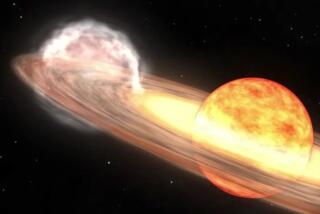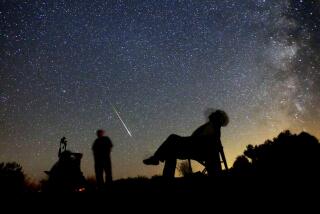Watch huge asteroid, and its traveling moon, fly by Earth today
Massive and dark, with a moon all its own, asteroid 1998 QE2 will fly safely past Earth on Friday afternoon, and you can watch it live, right here.
The live video feed will start at 1:30 p.m. PDT. The space rockâs closest approach to Earth will take place at 1:59 p.m.
The asteroid is estimated to be 1.6 miles in length -- large enough to cause global extinction if it hit our planet. Fortunately, there is absolutely no chance that will happen. Even at its closest approach Friday afternoon, the asteroid will still be 3.6 million miles from the Earth, or 15 times farther away than the moon.
At that distance, even this giant asteroid will be invisible to the naked eye. You might be able to see it with a 4- to 6-inch telescope, but even the most powerful light telescopes in the world would reveal the asteroid as a moving point of light across the sky.
To gather more detailed information about the space rock, scientists are tracking it using the 230-foot-wide Deep Space Network antenna at Goldstone, Calif., and a similarly enormous radar telescope at Arecibo Observatory in Puerto Rico.
ASTEROID QUIZ: Test your space rock knowledge
Using data collected by these powerful radar observatories earlier this week, scientists have already learned that asteroid 1998 QE2 is traveling with a moon roughly 2,000 feet in length, that the asteroid is spinning as it travels -- making a full rotation once every 5.3 hours, and that it likely has deep crevices on its surface.
The video feed youâll see above (weâll paste it in at 1 p.m. PDT), is from Slooh Space Cameraâs remote-controlled light telescope in the Canary Islands. Slooh frequently captures interesting events in the sky and shares them for free on the Internet
âIt will be fun to actually watch it change position,â said Bob Burman, a columnist for Astronomy magazine, in a statement. âAnd although it will not come nearer than 14 moon distances, thatâs still about 10 times closer than Mars can ever get.â







